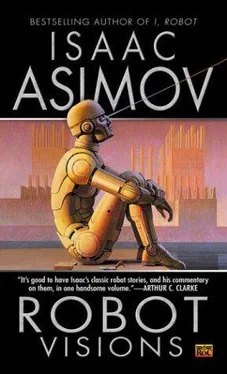Isaac Asimov - Robot Visions
Здесь есть возможность читать онлайн «Isaac Asimov - Robot Visions» весь текст электронной книги совершенно бесплатно (целиком полную версию без сокращений). В некоторых случаях можно слушать аудио, скачать через торрент в формате fb2 и присутствует краткое содержание. Жанр: Фантастика и фэнтези, на английском языке. Описание произведения, (предисловие) а так же отзывы посетителей доступны на портале библиотеки ЛибКат.
- Название:Robot Visions
- Автор:
- Жанр:
- Год:неизвестен
- ISBN:нет данных
- Рейтинг книги:5 / 5. Голосов: 1
-
Избранное:Добавить в избранное
- Отзывы:
-
Ваша оценка:
- 100
- 1
- 2
- 3
- 4
- 5
Robot Visions: краткое содержание, описание и аннотация
Предлагаем к чтению аннотацию, описание, краткое содержание или предисловие (зависит от того, что написал сам автор книги «Robot Visions»). Если вы не нашли необходимую информацию о книге — напишите в комментариях, мы постараемся отыскать её.
Robot Visions — читать онлайн бесплатно полную книгу (весь текст) целиком
Ниже представлен текст книги, разбитый по страницам. Система сохранения места последней прочитанной страницы, позволяет с удобством читать онлайн бесплатно книгу «Robot Visions», без необходимости каждый раз заново искать на чём Вы остановились. Поставьте закладку, и сможете в любой момент перейти на страницу, на которой закончили чтение.
Интервал:
Закладка:
“You will do nothing to Lenny.”
“For God’s sake, Susan, do I have to tell you First Law? A robot may not harm a human being or, through inaction, allow a human being to come to harm. Our entire position depends on the fact that First Law is rigidly observed by all robots of all types. If the public should hear, and they will hear, that there was an exception, even one exception, we might be forced to close down altogether. Our only chance of survival would be to announce at once that the robot involved had been destroyed, explain the circumstances, and hope that the public can be convinced that it will never happen again.”
“I would like to find out exactly what happened,” said Susan Calvin. “I was not present at the time and I would like to know exactly what the Randow boy was doing in my laboratories without my permission.”
“The important thing that happened,” said Lanning, “is obvious. Your robot struck Randow and the damn fool flashed the ‘Robot out of control’ button and made a case of it. But your robot struck him and inflicted damage to the extent of a broken arm. The truth is your Lenny is so distorted it lacks First Law and it must be destroyed.”
“It does not lack First Law. I have studied its brainpaths and know it does not lack it.”
“Then how could it strike a man?” Desperation turned him to sarcasm. “Ask Lenny. Surely you have taught it to speak by now.”
Susan Calvin’s cheeks Bushed a painful pink. She said, “I prefer to interview the victim. And in my absence, Alfred, I want my offices sealed tight, with Lenny inside. I want no one to approach him. If any harm comes to him while I am gone, this company will not see me again under any circumstances.”
“Will you agree to its destruction, if it has broken First Law?”
“Yes,” said Susan Calvin, “because I know it hasn’t.”
Charles Randow lay in bed with his arm set and in a cast. His major suffering was still from the shock of those few moments in which he thought a robot was advancing on him with murder in its positronic mind. No other human had ever had such reason to fear direct robotic harm as he had had just then. He had had a unique experience.
Susan Calvin and Alfred Lanning stood beside his bed now; Peter Bogert, who had met them on the way, was with them. Doctors and nurses had been shooed out.
Susan Calvin said, “Now-what happened?” Randow was daunted. He muttered, “The thing hit me in the arm. It was coming at me.”
Calvin said, “Move further back in the story. What were you doing in my laboratory without authorization?”
The young computer swallowed, and the Adam’s apple in his thin neck bobbed noticeably. He was high-cheekboned and abnormally pale. He said, “We all knew about your robot. The word is you were trying to teach it to talk like a musical instrument. There were bets going as to whether it talked or not. Some said-uh-you could teach a gatepost to talk.”
“I suppose,” said Susan Calvin, freezingly, “that is meant as a compliment. What did that have to do with you?”
“I was supposed to go in there and settle matters-see if it would talk, you know. We swiped a key to your place and I waited till you were gone and went in. We had a lottery on who was to do it. I lost.”
“Then?”
“I tried to get it to talk and it hit me.”
“What do you mean, you tried to get it to talk? How did you try?”
“I-I asked it questions, but it wouldn’t say anything, and I had to give the thing a fair shake, so I kind of-yelled at it, and-”
“And?”
There was a long pause. Under Susan Calvin’s unwavering stare, Randow finally said, “I tried to scare it into saying something.” He added defensively, “I had to give the thing a fair shake.”
“How did you try to scare it?”
“I pretended to take a punch at it.”
“And it brushed your arm aside?”
“It hit my arm.”
“Very well. That’s all.” To Lanning and Bogert, she said, “Come, gentlemen.”
At the doorway, she turned back to Randow. “I can settle the bets going around, if you are still interested. Lenny can speak a few words quite well.”
They said nothing until they were in Susan Calvin’s office. Its walls were lined with her books, some of which she had written herself. It retained the patina of her own frigid, carefully ordered personality. It had only one chair in it and she sat down. Lanning and Bogert remained standing.
She said, “Lenny only defended itself. That is the Third Law: A robot must protect its own existence.”
“Except,” said Lanning forcefully, “when this conflicts with the First or Second Laws. Complete the statement! Lenny had no right to defend itself in any way at the cost of harm, however minor, to a human being.”
“Nor did it,” shot back Calvin, “knowingly. Lenny has an aborted brain. It had no way of knowing its own strength or the weakness of humans. In brushing aside the threatening arm of a human being it could not know the bone would break. In human terms, no moral blame can be attached to an individual who honestly cannot differentiate good and evil.”
Bogert interrupted, soothingly, “Now, Susan, we don’t blame. We understand that Lenny is the equivalent of a baby, humanly speaking, and we don’t blame it. But the public will. U. S. Robots will be closed down.”
“Quite the opposite. If you had the brains of a flea, Peter, you would see that this is the opportunity U. S. Robots is waiting for. That this will solve its problems.”
Lanning hunched his white eyebrows low. He said, softly, “What problems, Susan?”
“Isn’t the corporation concerned about maintaining our research personnel at the present-Heaven help us-high level?”
“We certainly are.”
“Well, what are you offering prospective researchers? Excitement? Novelty? The thrill of piercing the unknown? No! You offer them salaries and the assurance of no problems.”
Bogert said, “How do you mean, no problems?”
“Are there problems?” shot back Susan Calvin. “What kind of robots do we turn out? Fully developed robots, fit for their tasks. An industry tells us what it needs; a computer designs the brain; machinery forms the robot; and there it is, complete and done. Peter, some time ago, you asked me with reference to Lenny what its use was. What’s the use, you said, of a robot that was not designed for any job? Now I ask you-what’s the use of a robot designed for only one job? It begins and ends in the same place. The LNE models mine boron. If beryllium is needed, they are useless. If boron technology enters a new phase, they become useless. A human being so designed would be sub-human. A robot so designed is sub-robotic.”
“Do you want a versatile robot?” asked Lanning, incredulously. “Why not?” demanded the robopsychologist. “Why not? I’ve been handed a robot with a brain almost completely stultified. I’ve been teaching it, and you, Alfred, asked me what was the use of that. Perhaps very little as far as Lenny itself is concerned, since it will never progress beyond the five-year-old level on a human scale. But what’s the use in general? A very great deal, if you consider it as a study in the abstract problem of learning how to teach robots. I have learned ways to short-circuit neighboring pathways in order to create new ones. More study will yield better, more subtle and more efficient techniques of doing so.”
“Well?”
“Suppose you started with a positronic brain that had all the basic pathways carefully outlined but none of the secondaries. Suppose you then started creating secondaries. You could sell basic robots designed for instruction; robots that could be modeled to a job, and then modeled to another, if necessary. Robots would become as versatile as human beings. Robots could learn!”
Читать дальшеИнтервал:
Закладка:
Похожие книги на «Robot Visions»
Представляем Вашему вниманию похожие книги на «Robot Visions» списком для выбора. Мы отобрали схожую по названию и смыслу литературу в надежде предоставить читателям больше вариантов отыскать новые, интересные, ещё непрочитанные произведения.
Обсуждение, отзывы о книге «Robot Visions» и просто собственные мнения читателей. Оставьте ваши комментарии, напишите, что Вы думаете о произведении, его смысле или главных героях. Укажите что конкретно понравилось, а что нет, и почему Вы так считаете.








